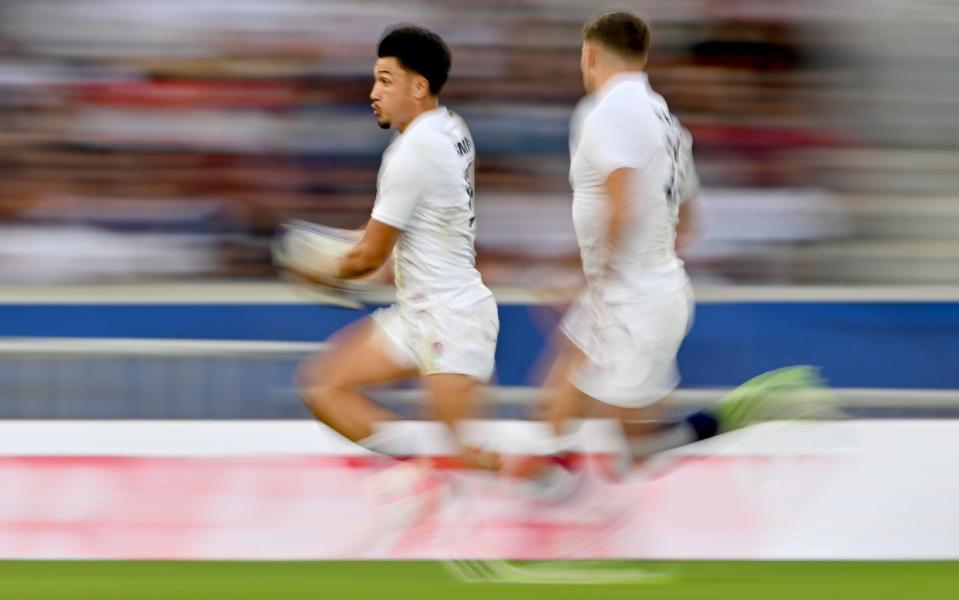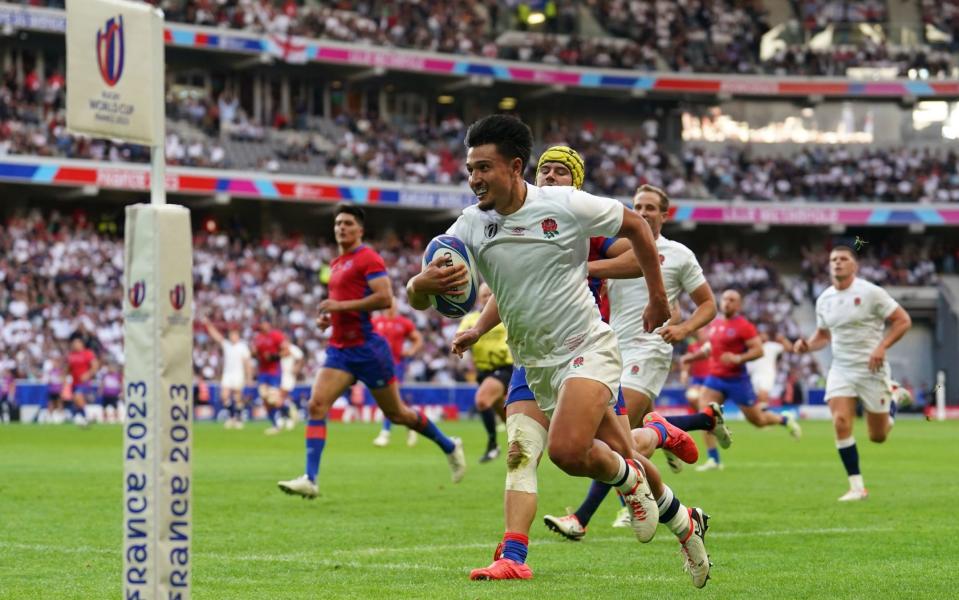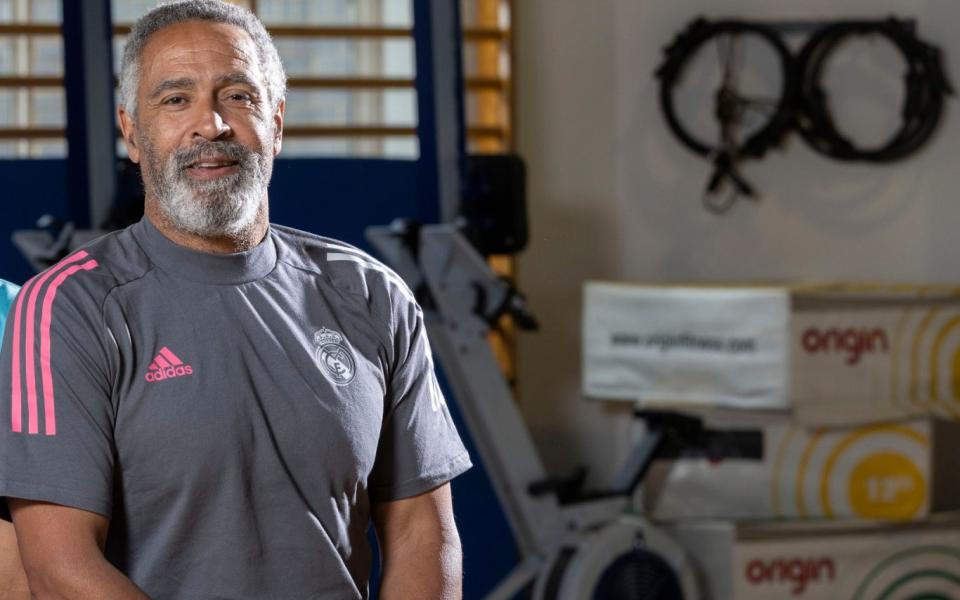How reduced ‘butt-kicking’ has transformed Marcus Smith into England’s fastest player

By Marcus Smith’s own admission he was a slow, chubby kid and even now he compares his running style to that of Forrest Gump.
Here Telegraph Sport details how the Harlequins fly-half has been transformed into England’s speed king, which has led to his redeployment at full-back, through an intensive training programme involving Olympic hero Daley Thompson and several world-leading sprint coaches.
Wing Henry Arundell has the fastest top-end speed within the England World Cup squad, yet in terms of raw acceleration (measured over 10 metres) Smith is the quickest, according to sprint coach Jonas Dodoo, who worked with the England team over 12 weeks this summer.
Not only does Dodoo confirm Smith as the fastest off the mark but his acceleration ranks at the “very high end” in his database of hundreds of athletes from rugby, football and the NFL. At Harlequins, Smith’s personal best 10-metre sprint time is 1.78 seconds. For context – and it is far from an exact comparison – Usain Bolt’s first 10 metres of his 2008 Olympic 100 metres final was measured at 1.85 seconds. It is this devastating turn of speed that has helped his transition to full-back where he left a trail of defenders in his wake for his solo try against Chile. “Off the mark he is frightening,” wing Jonny May said. “He just whizzes off the mark; that’s just how he runs. He’s an accelerating guy.”
So how did Smith develop such speed, particularly as his body shape is far removed from that of a typical sprinter, like the tall, muscular Arundell?
James Wild is head of research and development and speed consultant at Harlequins. He also has a PhD in biomechanics and motor control, specialising in acceleration in team sport athletes. Wild says Smith is “physically very gifted at accelerating”.
“The long and short of it is to run fast, it is about the force someone puts into the ground; the ability to put a lot of force into ground in a short timeframe and in the right direction,” Wild explains. “That determines how fast someone can run.

“Marcus possesses a trait that people might not see from the outside. Although he has quite a small stature, he takes really quite long steps. Relative to his height and leg length, he covers a lot of ground with each step and he is able to do that while maintaining a high cadence so his legs keep turning over. The freaky thing with Marcus is that there’s still a higher ceiling to reach, certainly in terms of his max velocity as well as acceleration.”
Then there is his thirst for knowledge and his desire to emulate the likes of All Blacks Richie Mo’unga, and Beauden Barrett. “They have the ability to score not just 10-metre tries but 50 or 60, and that is something that I wanted to add to my game,” Smith said.
Smith has consulted speed coaches from as far afield as the United States but found a pretty handy source far closer to his Brighton family home in the form of Thompson, the double Olympic decathlon gold medallist.
Thompson’s son, Alex Clayton, who is part of the wider Bath academy, went to Brighton College with Smith. From there a quasi-mentorship role developed where Thompson would make Smith repeatedly run up the 250-metre slope at Duke’s Mound just off the Brighton seafront while he stood at the top, smiling down, as well as being on call for general advice. “Credit goes to people that I’ve worked with down in Brighton, Daley Thompson, guys in America that I work with,” Smith said. “They put a lot of effort into me and I’ve loved every minute training with those guys. It’s been a joy and it has definitely opened my eyes to sprinting and speed work.”

When Smith started training with Harlequins senior squad as a teenager, he was ranked 16th for speed or “firmly in the middle of the park” according to Wild. What enabled him to shoot up the leaderboard was his physical development as well as technical adjustments focused on shortening what Wild calls his flight time.
“In other words, he is spending a long time in the air with each step,” Wild said. “We worked on some technical strategies to decrease that flight time because, ultimately, if you are in the air for a longer period of time the person next to you can get to their next step.”
Wild’s typical session with Smith at Harlequins would involve technical drills followed by free sprinting, contrasted with resisted sprints using bands or a sled. Then Wild would introduce medicine ball throws and plyometric jumps, which help to replicate the explosive power required for sprinting. By the end of last season, Smith ranked second only to winger Cadan Murley (1.77 seconds) in acceleration, although they have since been surpassed by centre Luke Northmore (1.74 seconds).
Yet since he started training with England in June under the eye of Dodoo, the head coach at Speedworks training, Smith has become even faster. “What he can do very well is from a standing start or from a low velocity he can project himself forwards,” Dodoo said. “Now he has got far more efficient in his running. His acceleration and his upright running all improved in key areas that he was aiming for. It is the culmination of the fact he is very coachable and that is something you get from being in a good coaching environment.”
Dodoo would work with England’s units for just 20 minutes a session, twice a week. For the first six weeks, he focused on increasing the players’ linear speed and improving their running efficiency. Sharing a video of Smith’s improvement with Telegraph Sport, Dodoo shows how he reduced what he calls his “butt kicking” tendencies. Conditioning is also crucial and Dodoo credits Tom Tombleson, England’s strength and conditioning coordinator for Smith’s physical gains.
This is a before and after video of a session Jonas Dodoo did with Smith at an England training session this summer in which he is upright sprinting, approaching his maximum velocity. In the pre-sprint trial, which is highlighted in red, Smith’s torso and pelvis are tilted forward which leads to a leg action where the foot cycles more behind the body in what Dodoo calls “butt kicking”.
In the after, highlighted in green, Smith has a more upright torso and pelvis which is deemed a neutral position. This leads to a leg action in which his foot cycles in a way which is more forward relative to his body. In turn this results in a more optimal foot strike by increasing the force applied to the ground with a shorter ground contact time.
Yet speed in isolation is only so effective. Dodoo is fully aware that rugby players do not run unimpeded over straight lines. Over the second half of the training camp, he introduced what he calls “elements of chaos” whether that is incorporating a swerve, running with a ball or eventually facing defenders. By the end of the camp, Dodoo’s sessions looked a lot like any other rugby drill.
Rather than use a stopwatch to record times, Dodoo, who also works with Newcastle United, Ajax and AC Milan, uses an app that relies on artificial intelligence. This creates a ‘speed score’ which compares not only athletes across many different sports but also body types as well so you are not comparing a prop to a wing. Although he cannot share his exact score, Dodoo says: “His score is really up there, not just for rugby players but across all sports. He is in the very high end.”

 Yahoo Sport
Yahoo Sport 




































